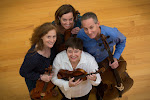Why do we do it? Why do we play string quartets?? Well - for the music, for the art, for the process , of course!
But …let me tell you what happened this time.
Larry’s message was from a father who is seeking the best spot for his daughter, a high-school cellist, to attend college as a music major. The father was relating how special it was for his daughter to be there, to talk with Larry afterwards, and to hear “the wonderful music Serafin String Quartet provided”. The gentleman said he drove almost 100 miles to get there will do it again in April (when SSQ will return to close Trinity’s season). “Every mile was worth driving,” the man wrote. How heartwarming for us to connect with this caring and attentive father, and how exciting that we were able to deliver an experience for his daughter, and for him, that they both want to repeat!!
Tim received a message from an adult amateur violinist who plays in the Community Orchestra. Hearing us play the Dohnanyi Piano Quintet triggered a touching reminiscence of her dear, life-long pianist friend, now in elder years and experiencing dementia. Today, her pianist friend can only poke a few notes out here and there, but at the time she “played a pretty mean piano!” This listener was spirited back 25 years, recalling how she and her friend, with some devoted others, read through the Dohnanyi from time to time, Hearing the quintet flooded this listener with memories of reading through the piece with this friend and their happy satisfaction at exploring this wonderful work together. “I treasure those times,” she wrote, “they were some of the most valuable times of my life. It’s what I call feeding the soul.” How gratifying for us to be a conduit for this listener to recall and reconnect with “what matters”.
I also received a message – mine from one of my nearest and dearest friends, who described herself as an “unsophisticated” listener, new to classical music. She shared with us her amazing experience of finding a thrilling and profound connection to her emotions while listening to the Mozart, Beethoven and Dohnanyi – each one evoking in her a different landscape of feelings, images and ideas. It was one of the most “tuned-in” expressions of the connecting to the content of the music that I have heard – and prompted me to assure her that, far from “unsophisticated”, she actually is tapped in to the real essence of the music - and completely “getting it” at the most important level – listening with a sophisticated heart!! For more than 30 years she believed she did not, would not, or could not appreciate classical music. How thrilling for us to be part of her discovery of the varied, deep, and expansive world of classical music and the riches it delivers to the attentive listener!!
These messages spanned 3 generations – and each was dramatic, heartfelt and enthusiastic – reinforcing my confidence in the greatness of the artworks of chamber music that we are so privileged to perform. And, more importantly - it reinforced to me their inherent accessibility and ability to touch any receptive heart! This, I must say, is why we do it!!
-Kate Ransom

